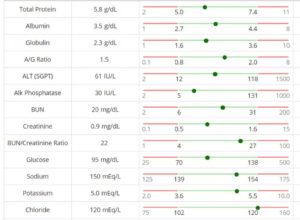
Editor’s Note: Healthy Paws is a column sponsored and written by the owners of Clarendon Animal Care, a full-service, general practice veterinary clinic and winner of a 2017 Arlington Chamber of Commerce Best Business Award. The clinic is located 3000 10th Street N., Suite B. and can be reached at 703-997-9776.
A couple of weeks ago we looked at the significance of the complete blood cell count. This week, we’ll be looking at the serum chemistry profile which has loads of useful information about metabolic function:
- Electrolytes, such as sodium, potassium, chloride, magnesium, phosphorous, calcium — electrolytes may be abnormal with dehydration (or overhydration in rare cases), kidney disease, advanced diabetes, hormonal imbalances and with some gastrointestinal diseases. The pattern of elevation or decrease can be especially helpful in ruling in and out some diseases.
- Blood sugar, or glucose — measure of how much “sugar” is circulating in the bloodstream; high elevations are seen with diabetes, though animals can develop a very transient elevation, or hyperglycemia), with stress. Low glucose levels, or hypoglycemia, can be seen with liver problems, some cancers, among other causes.
- Kidney values — kidney function is typically monitored by measuring certain enzymes or products that are typically eliminated by the kidney. The two most commonly measured values are creatinine and blood urea nitrogen (or BUN); the term for elevation is “azotemia”:
- Creatinine — produced by muscle and eliminated by the kidney. Elevations indicate decreased kidney function or severe muscle damage.
- BUN — urea is produced by the liver (so may actually be low with significant liver disease), but eliminated by the kidneys, thus increasing with decreased kidney function. However, high protein diets and GI bleeding are other potential causes of elevations.
- Calcium and phosphorous levels can also be affected with more significant kidney disease.
- Liver values — here again, several different values are typically measured:
- ALP — alkaline phosphatase — may be increased with conditions that cause “stasis” in the liver, but also can be induced by certain drugs such as prednisone (a commonly used steroid medication). ALP can also be produced by bones, and mild elevations are not uncommon in growing dogs.
- ALT — alanine aminotransferase — elevations typically indicate ongoing damage or irritation of the liver.
- GGT — gamma glutamyl transferase — similar to ALP, but more specific to the liver.
- Total bilirubin — bilirubin is the molecule responsible for causing a jaundiced or icteric color to the skin, eyes and mucous membranes in individuals with significant liver disease. May also be elevated with a form of anemia in which the body destroys its own red blood cells.
- Blood proteins
- Globulins — may be increased with inflammation, some cancers (i.e. multiple myeloma); decreases can be seen with blood loss and with more severe gastrointestinal diseases.
- Albumin — may be elevated with dehydration, and decreased with blood loss, liver disease, gastrointestinal disease, kidney disease or destruction of red blood cells.
There are many other biochemical values that can also be measured from the blood, providing valuable information about heart health, pancreatic inflammation, cholesterol levels, thyroid hormones and so much more! Veterinarians today are fortunate to practice in an era when so much information is accessible in such a short period of time.


